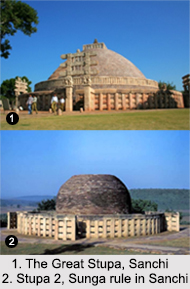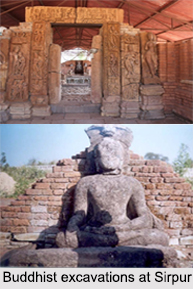 The central Indian states of Madhya Pradesh and Chhattisgarh house important sites of Buddhism, be it the UNESCO World Heritage Site of Sanchi famous for the Buddhist vihara, the Great Stupa or the multiple viharas excavated in Sirpur.
The central Indian states of Madhya Pradesh and Chhattisgarh house important sites of Buddhism, be it the UNESCO World Heritage Site of Sanchi famous for the Buddhist vihara, the Great Stupa or the multiple viharas excavated in Sirpur.
Buddhist Monuments at Sanchi, Uttar Pradesh
The town of Sanchi in the Raisen district of Madhya Pradesh is a UNESCO World Heritage Site, listed as Buddhist Monuments at Sanchi. It is famous for the Great Stupa, which is the oldest stone structure in India. Originally commissioned by emperor Ashoka in the 3rd century BCE, its nucleus was a simple hemispherical brick structure built over the relics of Gautama Buddha, crowned by a Chatra, parasol-like structure symbolizing high rank intended to honour and shelter the relics. The construction work of the Sanchi Stupa was overseen by Ashoka`s wife, Devi herself. Sanchi was also her birthplace as well as the venue of her and Ashoka`s wedding. In the 1st century BCE, four elaborately carved Toranas, ornamental gateways along with a balustrade encircling the entire structure were added to the stupa.
 In the Mauryan period, a pillar of finely polished sandstone was erected in Sanchi, with its bottom portion standing today. The upper parts of the pillar lie placed under a canopy nearby. The pillar also has an Ashokan inscription and an inscription in the ornamental Sankha Lipi from the Gupta era. Two further stupas were erected at the town during the Shunga Dynasty reign. Many more temples and monasteries came up between the 2nd and the 12th centuries AD, most of which lie today in a state of ruins. The Gupta Temple dating back to the 5th century is the best preserved monument in Sanchi, boasting the glory of the Gupta Empire in the historic town.
In the Mauryan period, a pillar of finely polished sandstone was erected in Sanchi, with its bottom portion standing today. The upper parts of the pillar lie placed under a canopy nearby. The pillar also has an Ashokan inscription and an inscription in the ornamental Sankha Lipi from the Gupta era. Two further stupas were erected at the town during the Shunga Dynasty reign. Many more temples and monasteries came up between the 2nd and the 12th centuries AD, most of which lie today in a state of ruins. The Gupta Temple dating back to the 5th century is the best preserved monument in Sanchi, boasting the glory of the Gupta Empire in the historic town.
Viharas in Sirpur, Chhattisgarh
The lost historic town of Sirpur in the Mahasamund district of Chhattisgarh, houses a number of Buddhist viharas. Buddha Vihara is a prominent attraction here, exuding warmth and religious harmony. Brick constructions and underground rooms stand testimony to a mystical era and the tone blend reminds of the temples and residential buildings of the Gupta dynasty. Buddha Vihara houses a 6-feet tall statue of Buddha, touching the earth. The many residential, meditation and study rooms display a glimpse of the Lord"s long lived glory. Enchanting inscriptions reveal that the ardent Buddha follower Anandprabhu created a 14-room shelter with welcome gates and "dwarapalas" on either side carved in stone pillars. The shelter is called Anandprabhu Kutir Vihara, named after its creator. Swastika Vihara was also excavated to reveal a huge Buddha statue and metal idols pertaining to the Buddhist era. Recent excavations have also revealed 12 Buddhist viharas and monolithic statues of Buddha.



















